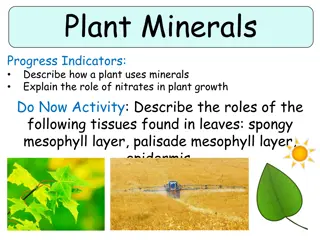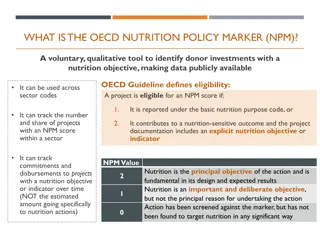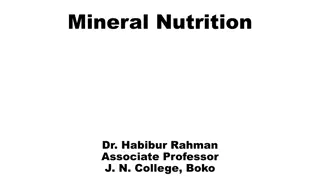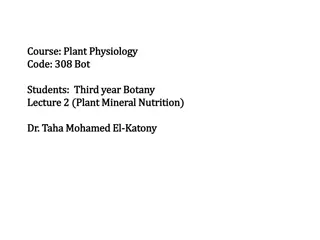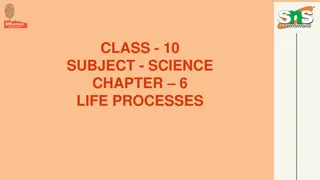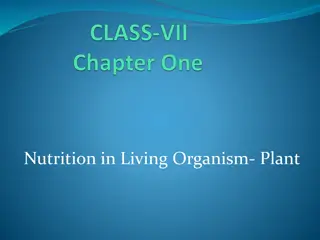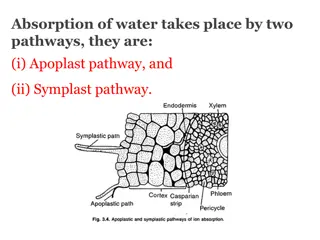Understanding Mineral Nutrition in Plants
Mineral nutrition in plants involves the acquisition of essential elements in the form of inorganic ions from soil, followed by their absorption and utilization in various plant processes. Around 60 different elements have been reported in plants, with 30 being essential for plant growth. These essential elements are classified as macronutrients or micronutrients based on their concentration in plant tissue. The criteria of essentiality, introduced by Arnon and Stout in 1939, define the indispensability of these elements for plant growth. The classification of plant nutrients is based on their biological roles and physiological functions, categorizing them into four basic groups based on their importance in plant biochemistry and metabolism.
Download Presentation

Please find below an Image/Link to download the presentation.
The content on the website is provided AS IS for your information and personal use only. It may not be sold, licensed, or shared on other websites without obtaining consent from the author. Download presentation by click this link. If you encounter any issues during the download, it is possible that the publisher has removed the file from their server.
E N D
Presentation Transcript
BOT323 MINERAL NUTRITION
INTRODUCTION MINERAL NUTRIENTS ARE ELEMENTS acquired primarily in the form of inorganic ions from the soil. Only way of entry of minerals in biosphere is through the roots of the plants. After absorption mineral nutrient are transported to various locations in the plants where they are utilized in different processes. The study of how plants obtain and use mineral nutrients is called MINERAL NUTRITION.
About 60 different elements have been reported in plants out of which 30 are present in all plants. Out of 30, 16 elements are essential and rest are non-essential. This essentiality and non-essentiality of the mineral elements is governed by CRITERIA OF ESSENTIALITY.
CRITERIA OF ESSENTIALITY Given by Arnon and Stout in 1939. It states that A plant must be unable to grow in the absence of essential elements. It must be irreplaceable, i.e. specific for a particular plant function. It must be directly involved in the nutrition of the plants.
Essential mineral elements are usually classified as macronutrients or micronutrients, according to their relative concentration in plant tissue. Macronutrients Required by plants in larger quantities C, H, O, N, P, K, S, Ca, Mg, Fe Micronutrients Required in small amounts Cu, Zn, Mn, Mo, B, Cl
Table: Adequate tissue levels of elements that may be required by the plants.
The classification into macro and micronutrients is difficult to justify. Hence they must be classified based on their biological role and physiological function. Hence plant nutrients can be divided into four basic groups: The first group of essential elements forms the organic (carbon) compounds of the plant. Plants assimilate these nutrients via biochemical reactions involving oxidation and reduction.
The second group is important in energy storage reactions or in maintaining structural integrity. The third group is present in plant tissue as either free ions or ions bound to substances such as the pectic acids present in the plant cell wall. The fourth group has important roles in reactions involving electron transfer.
DEFICIENCIES OF GROUP 1 MINERAL ELEMENTS Nitrogen Required in greatest amount Important for amino and nucleic acids Deficiency inhibits plant growth Severe deficiency can cause chlorosis and ultimately leaves die Sulfur Found in two amino acids and essential for metabolism Symptoms include chlorosis, stunting of growth and anthocyanin accumulation Chlorosis generally occur throughout the plant
DEFICIENCIES OF GROUP 2 MINERAL ELEMENTS Phopshorus Characteristic symptoms of phosphorus deficiency include stunted growth in young plants Dark green coloration of the leaves, which may be malformed and Contain small spots of dead tissue called necrotic spots Also include production of slender stem and death of older leaves.
Silicon Plants deficient in silicon are more susceptible to lodging (falling over) and fungal infection. It also forms complexes with polyphenols and thus serves as an alternative to lignin in the reinforcement of cell walls. In addition, silicon can ameliorate the toxicity of many heavy metals. Boron A characteristic symptom is black necrosis of the young leaves and terminal buds. Stems may be unusually stiff or brittle. Apical dominance may be lost. Structures such as fruits and tubers exhibit necrosis.
DEFICIENCIES OF GROUP 3 MINERAL ELEMENTS Potassium Marginal chlorosis Dying of leaf tip Appear at mature leaves Stem is slender and weak with abnormally short internodes. Calcium Necrosis of young meristamatic regions Downward hooking of young leaves Root system appear brownish, short, and highly branched. Severe stunting may result.
Magnesium Chlorosis between leaf veins. Leaves may become yellow or white. It may also lead to premature abscession. Chlorine Required in oxygen evolution in photosynthesis. Deficiency starts with wilting of leaf tip and proceeds to general necrosis of leaves. Leaf growth is reduced. Leaves appear bronze in color. Roots of chlorine deficient plants are stunted.
Manganese Main symptom is intervenous chlorosis associated with development of small necrotic spots. Sodium C4 and CAM plants require Na ions. Required for regeneration of PEP. Under Na deficiency flowering fail to occur in these plants.
DEFICIENCY OF GROUP 4 MINERAL ELEMENTS Iron Intervenous chlorosis in younger leaves. After some time leaf starts to turn white. Zinc Reduction in internodal growth. Plant shows rosette habit of growth. Leaves are small and distorted. Leaf margins usually have a puckered appearance.
Copper Also involve in electron transfer reactions eg. Plastocyanin. Initial symptom of Cu deficiency is production of dark green leaves with development of necrotic spots. Necrotic spots generally spread along margins. Leaves also appear twisted and malformed. Premature abscision of leaves may occur. Nickel Nickel deficiency in plants leads to accumulation of user in their leaves. Leaf tip necrosis is also observed.
Molybdenum The first indication of a molybdenum deficiency is general chlorosis between veins and necrosis of the older leaves. Molybdenum deficiency can also lead to nitrogen deficiency.





